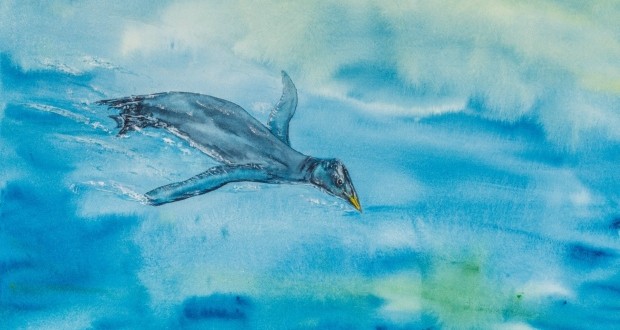A Sooke, B.C. family’s walk on the beach turned into a paleontology expedition when they stumbled upon a rare find: a 25-million-year-old bird fossil embedded in a slab of rock.
The fossil was in good enough condition for researchers to identify the animal as a new species of a plotopterid, a long-extinct penguin or cormorant-like bird never before found in Canada.
A collarbone from the bird was found inside a slab of rock on a Sooke, B.C., beach.
It’s only the second set of fossilized bird bones found on southern Vancouver Island since 1895, said bird expert Gary Kaiser of the Royal B.C. Museum.
Fossils of birds are extremely rare because the fragile and hollow bones don’t hold up to crushing weight, acidic soils and elements like other fossils do.
“They get broken up, crushed easily,” Kaiser said in an interview Tuesday. “The bones simply dissolve. They disappear.”
In this case, the sandstone and lack of acid in the water seemed to preserve the fossil, he said.
A father, daughter and son were out for a walk two years ago when they found the bone in a slab of rock that had fallen from the nearby cliffs, he said.
The daughter spotted the fossil. Her brother carried the slab off the beach, before the father brought it to the museum.
Next to a skull, the collarbone is the best bone to find because it sits at the shoulder where the wings function and where the collar blade, arm bone and sternum are attached.
“It is the most informative bone in a bird skeleton. It tells you more than anything else about what the bird does for a living,” Kaiser said.
The long, skinny bone wasn’t anything like he had ever seen before.
“Right away, I knew it was an unusual bone,” he said, noting that’s when he linked it to the plotopterid fossil.
Relatives of the bird have been found in Japan and in Oregon and California, but none has been as small.
“Of those several hundred birds, all but two of them are huge. I mean they’re birds that probably weighed 200 kilograms when they were alive and stood six-foot tall,” Kaiser said.
This animal was about the size of cormorant.
Kaiser said he believes that if they had the fossil’s brain case the animal would look like a penguin, but an American man who studies plotopterids is convinced they are more like cormorants.
“It’s a bit of a fight, but not unusual in biology because there’s no way of telling,” he added.
Agencies/Canadajournal
 Canada Journal – News of the World Articles and videos to bring you the biggest Canadian news stories from across the country every day
Canada Journal – News of the World Articles and videos to bring you the biggest Canadian news stories from across the country every day



